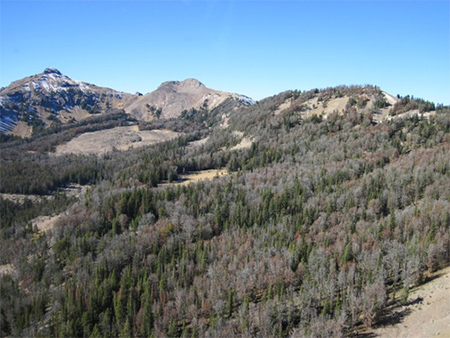Native Plant Conservation Campaign News: Whitebark pine is first widespread keystone tree to be listed under the federal Endangered Species Act
December 4, 2020
Wednesday, the U.S. Fish and Wildlife Service proposed listing the Whitebark pine as a threatened species under the federal Endangered Species Act. The proposed listing is important for several reasons.
First, Whitebark pine is extremely widespread species and is an icon of the U.S. west. Its range covers more than 80.5 million acres in seven western states (Washington, Oregon, California, Idaho, Montana, Wyoming, Nevada) and Canada. It is a keystone species, dominating high elevation forests. It provides shelter allowing species to survive in harsh mountain conditions and is a foundation of the food web that supports myriad wildlife, including the Grizzly bear. Its branches block wind and provide shade that prolongs snowmelt, regulating spring runoff, while its roots hold soil in place, reducing the potential for flooding and erosion to damage forests and downstream communities.
Second, the species is in extreme decline. White pine blister rust, a non-native fungal disease, mountain pine beetles, climate change, and fire  suppression all negatively affect the species’ health. Climate change not only directly harms the species by altering temperature regimes, it facilitates invasion by mountain pine beetles into higher elevations. Scientists estimate that fully 51% of standing whitebark pine trees were dead as of 2016.
suppression all negatively affect the species’ health. Climate change not only directly harms the species by altering temperature regimes, it facilitates invasion by mountain pine beetles into higher elevations. Scientists estimate that fully 51% of standing whitebark pine trees were dead as of 2016.
 suppression all negatively affect the species’ health. Climate change not only directly harms the species by altering temperature regimes, it facilitates invasion by mountain pine beetles into higher elevations. Scientists estimate that fully 51% of standing whitebark pine trees were dead as of 2016.
suppression all negatively affect the species’ health. Climate change not only directly harms the species by altering temperature regimes, it facilitates invasion by mountain pine beetles into higher elevations. Scientists estimate that fully 51% of standing whitebark pine trees were dead as of 2016.Third, the federal government in general, and the Trump administration in particular, has been reluctant to acknowledge or address climate change, let alone publicly attribute the imperilment of species to it. This is one of the first times in history that climate change has been accepted as a reason for species listing. Despite the obvious effects of climate change on forests worldwide, Whitebark pine is the first tree to be proposed for protection under the Endangered Species Act because of climate change.
Finally, Endangered Species Act protection has been withheld from the species since it was first petitioned for listing in 2008. At the time of the 2008 petition, studies showed 80% of the whitebark pine forests in the Greater Yellowstone Ecosystem were already dead or dying, according to the Natural Resources Defense Council. Thus although Wednesday’s action is welcome, it is long overdue. Federal inaction for more than a decade has allowed its continued decline across its enormous range.
As a federally threatened species, protections for Whitebark pine would include prohibiting the removal of Whitebark pine from federal lands and prohibiting Whitebark pine import, export and activities related to interstate and foreign commerce. The government did not designate critical habitat for Whitebark pine. This omission will make recovery more difficult because measures such as “ identifying the places [the tree is] most likely to survive and providing them with protection from threats like ski areas and other development … and guiding restoration towards the most important areas” would be less likely to be taken, according to the Center for Biological Diversity.
The scope of this catastrophe for this widespread keystone species dramatically shows how federal apathy, climate change and other human damage is destroying the life support system of our country and planet.
Read about the proposal in the San Francisco Chronicle
Photo: Dying Whitebark pine © Natural Resources Defense Council